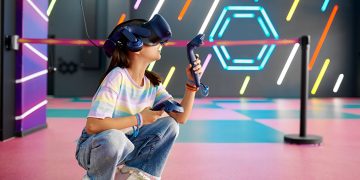Evening descends on the city, and my apartment transforms into a portal to countless worlds. With my AR headset on, the physical walls dissolve into a canvas of augmented experiences. Holographic avatars of friends appear around my living room, each projected with perfect spatial awareness, gestures, and expressions. We are in the same physical space and yet simultaneously connected across continents.
AR has made social interaction both richer and more fluid. Traditional video calls limit presence to a flat screen, but AR allows shared experiences within a blended reality. We can play virtual board games, watch concerts together, or explore collaborative art installations while remaining in our own homes.
Gaming and Immersive Experiences
One of the most visible applications of AR in entertainment is gaming. AR games overlay digital content onto real-world environments, turning mundane streets, parks, and rooms into interactive playgrounds.
I step into the park, and my AR interface populates the space with creatures, treasure chests, and challenges. Players from nearby neighborhoods appear as holographic avatars, collaborating or competing with gestures and movements. The game is not confined to a device; it reshapes the real world itself, blending imagination and reality seamlessly.
AR gaming enhances spatial awareness, problem-solving, and coordination. Unlike traditional video games, players must navigate physical space, which creates a dynamic, embodied form of interaction. Psychologists note that this kind of active engagement improves cognitive flexibility and social skills.
AR in Social Interaction
AR is not limited to entertainment—it fundamentally reshapes social interactions. Imagine a café where each table is augmented with shared digital experiences: interactive menus, collaborative puzzles, or storytelling overlays. Friends can leave messages, holographic graffiti, or art projects visible only to chosen groups.
Even casual encounters are transformed. Virtual introductions, context-aware avatars, and location-based overlays provide cues and enrich communication. People can see friends’ interests, shared memories, or live digital annotations, all without intrusive devices. Social presence is enhanced while remaining optional, allowing for deeper, more meaningful interactions.
AR also fosters empathy and understanding. Through shared augmented experiences, users can step into others’ perspectives, view data overlays about emotions or intent, and participate in simulations that encourage awareness and collaboration.
Entertainment Beyond Gaming
Movies, concerts, and live performances gain new dimensions with AR. Holographic projections, interactive overlays, and contextual information enhance engagement.
I attend a live music performance while sitting in my apartment. The band appears on my stage as if present in the room. Lyrics, instrument paths, and sound visualizations float around, synchronized with the music. Audience reactions from around the world appear as avatars, creating a sense of shared presence. AR transforms passive viewing into participatory experience, making entertainment deeply immersive and socially connected.
Museums and cultural events also benefit. AR allows viewers to interact with exhibits, animate historical artifacts, or overlay stories that unfold as they move through spaces. Educational entertainment becomes possible, combining learning with engagement seamlessly.
Psychological and Social Impacts
AR reshapes human perception, attention, and interaction. Socially, it enables global connections while maintaining local presence. Psychologically, immersive AR experiences increase engagement, motivation, and emotional resonance.
However, there are challenges. Prolonged AR use can blur the line between physical and digital realities, affecting social skills, attention, and mental health. Designers must balance immersion with usability, ensuring that augmented experiences complement rather than dominate real-life interactions.
Privacy is another concern. AR captures location, gestures, and social behavior. Ethical design requires transparency, consent, and protection of personal data. AR experiences should empower users, not exploit or manipulate them.

Commercial and Creative Applications
Brands, artists, and content creators leverage AR to engage audiences creatively. Retail stores use AR to showcase products in users’ homes. Artists create interactive installations that respond to gestures and presence. Event organizers enhance concerts, festivals, and conventions with augmented overlays that provide information, games, or narrative layers.
Collaborative creation is another frontier. Groups of users can co-create digital art, music, or narratives in shared AR spaces, combining creativity, technology, and social engagement. AR democratizes access to creative tools, allowing anyone to participate in immersive artistic expression.
AR for Everyday Life and Routine Enhancement
AR is no longer limited to leisure—it augments everyday life. Restaurants provide AR menus; cities offer AR wayfinding; workplaces integrate AR dashboards. Entertainment and social AR experiences often blend seamlessly with practical applications, creating a unified environment where work, play, and socialization coexist.
For example, a weekend park stroll can simultaneously serve as a fitness routine, a social interaction, and a game adventure. AR gamifies routine tasks, enhancing motivation, engagement, and enjoyment. Daily life becomes interactive, informative, and playful.
Future Directions
The future of AR in entertainment and social life is expansive:
- Mixed-Reality Communities: Virtual neighborhoods layered over physical spaces for socializing, education, and commerce.
- Personalized Immersion: AR systems adapt content based on preferences, moods, and context, creating highly individualized experiences.
- Cross-Platform Integration: AR merging with VR, AI, and IoT for seamless experiences across devices and environments.
- Ethical Design: Focus on consent, data privacy, and user well-being while maximizing engagement and creativity.
- Hybrid Events: Live and digital audiences sharing experiences in real-time, transforming entertainment into a participatory, inclusive phenomenon.
Conclusion: Augmenting Human Connection
AR transforms entertainment and social life by bridging physical and digital worlds. It fosters creativity, engagement, and connection, turning passive observation into active participation.
The human experience becomes layered, interactive, and collaborative. AR amplifies our senses, extends our social reach, and provides new avenues for play, learning, and expression. Yet, this power requires mindfulness, ethical design, and intentional use.
As we inhabit these augmented spaces, AR becomes a partner, not a replacement—enhancing enjoyment, empathy, and social interaction. Life in augmented reality is richer, more connected, and increasingly intertwined with our physical presence, offering new ways to experience the world together.












































